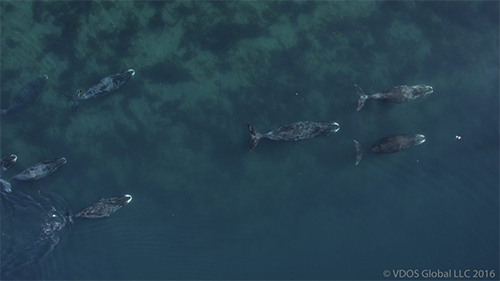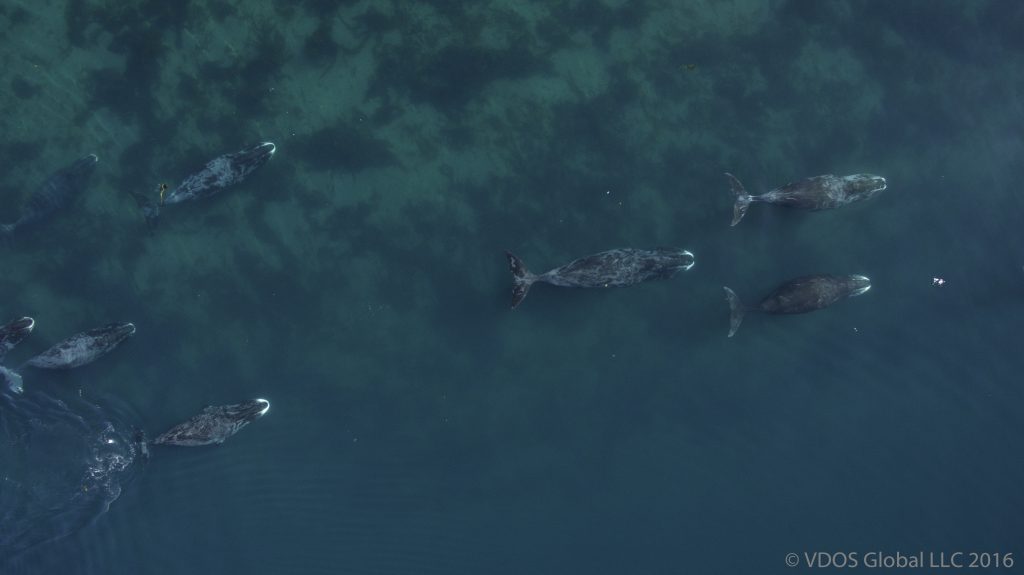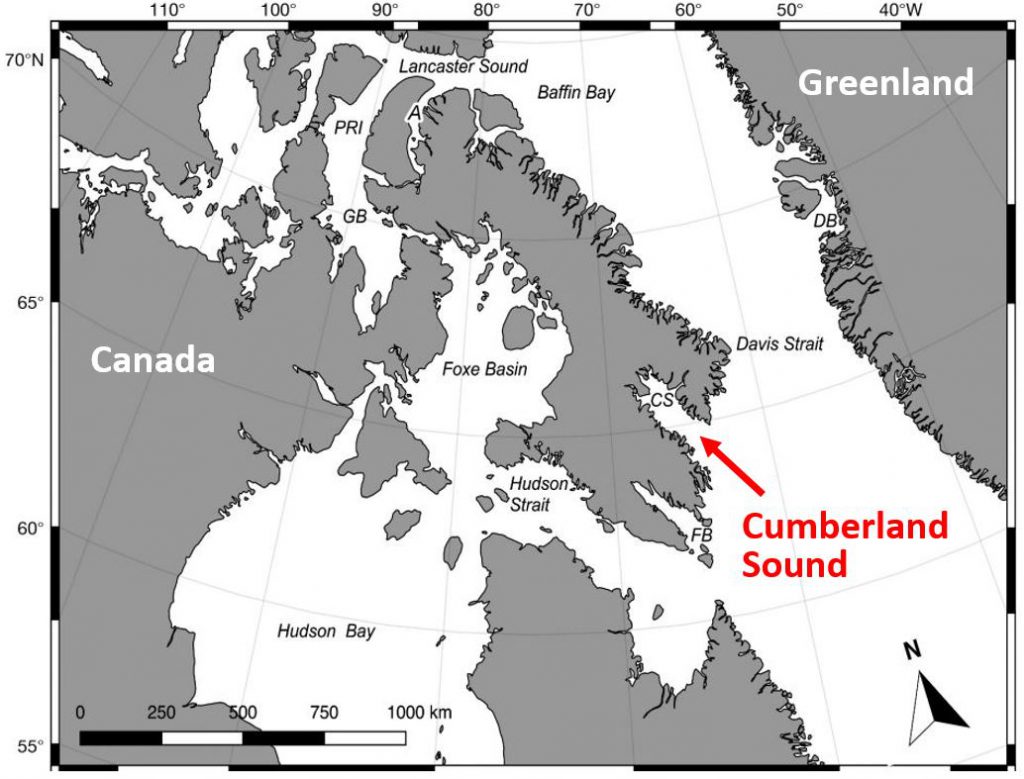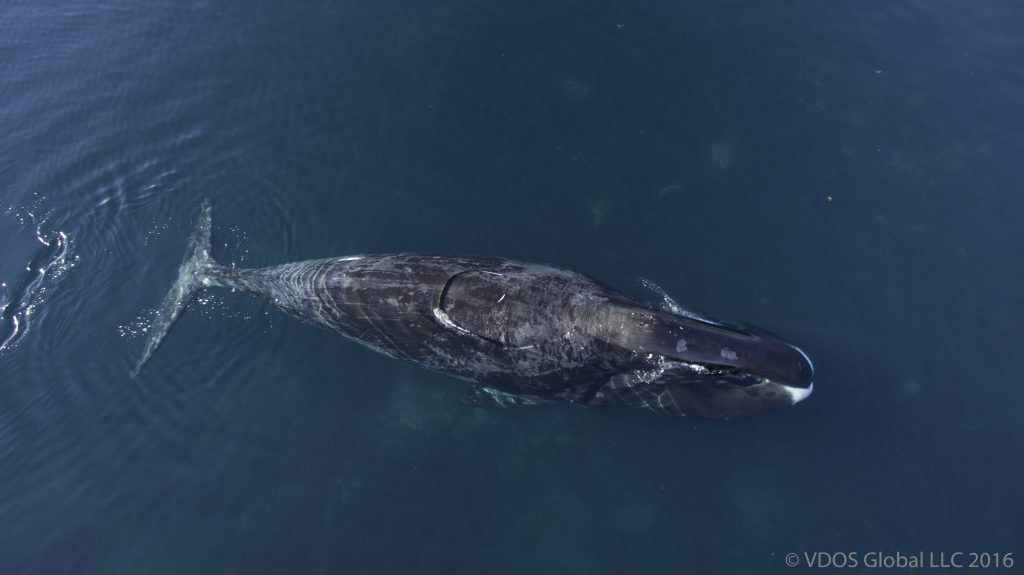
Satellite telemetry and time-depth recorders are providing new and surprising insights into the secret lives of bowhead whales

Bowhead whales traveling along the shore in Cumberland Sound, Nunavut during summer 2016. Image captured by unmanned aerial system (VDOS Global LLC) with support from World Wildlife Fund Canada.
Bowhead Whales live year-round in Arctic and sub-Arctic waters and are split into different geographic populations. One of these populations—the Eastern Canada – West Greenland population—generally summers in western Baffin Bay, the Canadian High Arctic, northern Foxe Basin, northwestern Hudson Bay and Cumberland Sound. Wintering is thought to occur in areas with less ice such as Hudson Strait.
However, new research shows that at least one of these areas—Cumberland Sound (Nunavut, Canada)—is an important year-round feeding ground for bowhead whales.

Map of the known range of Eastern Canada-West Greenland bowhead whales with important areas identified (FB=Frobisher Bay, DB=Disko Bay, A=Admiralty Inlet, PRI=Prince Regent Inlet and GB=Gulf of Boothia).
In a recently published paper in the journal Marine Ecology Progress Series, University of British Columbia (UBC) Post-Doctoral Fellow Sarah Fortune reported the results of a 4-year study on the seasonal diving and foraging behaviors of Eastern Canada – West Greenland bowhead whales in Cumberland Sound.
Dr. Fortune and her team from Fisheries and Oceans Canada (Steve Ferguson, Justine Hudson and Bernard LeBlanc), Woods Hole Oceanographic Institution (Mark Baumgartner), and UBC (Valery LeMay and Andrew Trites) tracked 25 bowheads with satellite-linked time-depth telemetry tags to determine movements and dive behaviors. They also collected zooplankton samples in Cumberland Sound to determine prey species and biomass.
Prey sampling data suggested that the bowheads in Cumberland Sound were eating energy-rich Arctic copepods such as Calanus glacialis during summer. Dive depths were substantially shallower during spring and summer compared to fall and winter, and appear to correspond with seasonal changes in the vertical distribution of the copepods—which suspend development and overwinter at depth during fall and winter.

An individual bowhead whale resting near the surface in Cumberland Sound, Nunavut during summer 2016. Image captured by unmanned aerial system (VDOS Global LLC) with support from World Wildlife Fund Canada.
The researchers also found that bowhead dive depths changed with time of day—providing evidence that their prey are migrating each day up and down the water column. Zooplankton avoid predation from visual predators by staying away from the sunlight surface waters during daylight, and move to the surface waters to eat phytoplankton at night.
One of the big surprises of Dr. Fortune’s research was finding that bowhead whales resided in Cumberland Sound during all four seasons, with one animal remaining all year. Some of the whales she followed were infrequent visitors to Cumberland Sound, spending only a day to several weeks, while others had considerably longer residency times, spending several consecutive months in the area that occasionally included overwintering. However, peak bowhead occupancy occurred during summer and fall.
The satellite telemetry locations also showed movement patterns indicative of feeding—suggesting that Cumberland Sound is a year-round feeding area.
These findings provide a new understanding of the feeding behavior of bowhead whales, and the biological significance of Cumberland Sound to the Eastern Canada – West Greenland population.
Dr Sarah Fortune is a Post-Doctoral Fellow at the Marine Mammal Research Unit at the University of British Columbia
This research was made possible through the support of our community partners, Levi Qaunaq and Natalino Piugattak from Igloolik, and Noah Ishulutaq and Timeosie Akpalialuk from Pangnirtung, who were responsible for vessel operations. Logistical support was provided by the Igloolik and the Pangnirtung Hunters and Trappers Organizations and the Government of Nunavut. Bowhead whale data were collected under UBC ACC A14-0064 and Department of Fisheries and Oceans License to Fish for Scientific Purposes S-12/13-1014-NU and S-13/14-1009-NU and Animal Use Protocol FWI-ACC-2012-034 and FWI-ACC-2013-018.
 PUBLICATION
PUBLICATION
2020 | ||||||||||||||

|

|

|
||||||||||||
